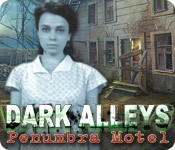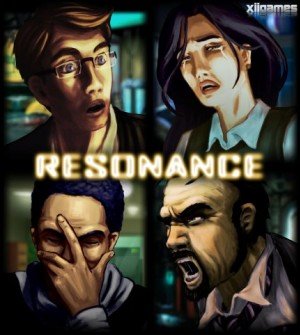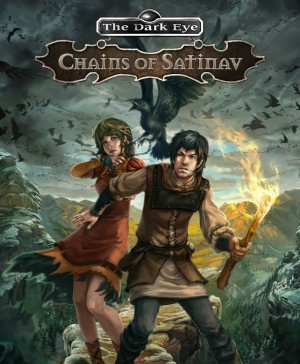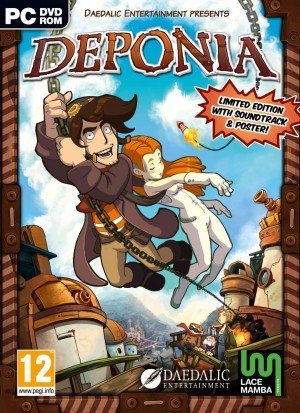Review for Hoodwink

Out of nowhere, indie Malaysian developer E-One Studio announced their debut adventure game Hoodwink mere weeks before release. Promising conspiratorial intrigue combined with dark, twisted humour in an adventure about a smart-mouthed scoundrel, all set in a dystopian future with a unique art style, it sure sounded good. Maybe even too good to be true? In some ways it is. The game really does have all of the above, but it has several serious downsides too, which can't be overlooked, especially the fact that it's not a standalone adventure.
The world where Hoodwink takes place is called Global-01. It's not a very nice place, as we witness when the game starts – which doesn't happen until after we've given Unicorp, the world's most powerful mega-corporation, our 32-digit product key (no copy-pasting!) to activate. Players assume the role of a young man named Michael Bezzle, a thief (though he prefers “acquisition expert”) who's broken into an office to steal one last item, a precious ring with which to propose to his girlfriend Francesca, a beautiful and brilliant woman who is somehow attracted to him. He'll also need chocolates and flowers, and those are hard to come by in a world where only those with power and money can afford to buy luxuries. When the rightful office occupant, a giant cat-like creature named Detective Pyre, walks in, Michael is in even deeper trouble than usual, but he manages to escape. Then the real adventure starts, in a quest to accumulate the necessary items for the proposal. The flowers, for instance, are guarded by a ferocious killer plant that won't stand still to get picked, while hippie stall owner Saffron has just sold her last box of chocolates. The ring still needs to be engraved with Francesca's name as well.
The screenshots don't really do Hoodwink justice, as the game itself looks far better and much less blurry in action. The cel-shaded graphics are a pleasure to look at even if the world itself is far from pretty, with garbage everywhere and patched-up buildings in obvious states of decay. It can be hard to distinguish between background clutter and useful items, unfortunately, and Michael walks like he's just soiled his pants in a bad way. Maybe he has, mind you, as the only food for sale on the streets is grilled rat, which is far from fresh and crawling with cockroaches. Global-01 is recovering from an epidemic and it looks like another is on its way. While slightly cartoony, the visuals really work, giving the action a dark, ominous atmosphere without feeling too oppressive. The ambience is further enhanced by a jazzy soundtrack that imbues a great film noir feel with lots of saxophone, growing more dynamic during cutscenes.
Michael's comments give us an excellent idea about the world he lives in, though much of it is by association rather than directly. For instance, there is a very (really, very) large litter box underneath the office desk, but all Michael cares about is that the desk is made of something cheap called Shamwood, which is common now that real wood is no longer available. And when he meets a depressed cyborg, he recalls that “Second Chancers” have only their brains left intact from their old bodies, courtesy of Unicorp, from which we can deduce how people are punished for crimes. The world feels believable, with plenty of little details both visual and aural. Advertising is everywhere, as a sound system blares out how wonderful Unicorp is for supplying everyone with their medication on every street corner.
As you explore, you'll see numerous people (including androids and giant cats called anthros) standing in the streets, talking to each other. When you get close, you can hear them speaking to each other, which isn't important for the story but does help to make the game world feel alive. Unfortunately, you can't interact with them in any way, and their lines do repeat after a few sentences. Some people on opposite sides of the same location even have the same lines, which spoils the principle a bit. Despite the desperate condition the world is in, humour is present in descriptions and dialogues (have you ever tried to convince a robot that it can't possibly be hungry?) and some situational comedy. It's a cynical, gritty kind of humour involving the sad state of the world and the inability of the populace to do anything about it, but it generally works well to lighten the mood.
Michael's tasks involve conversing with people and androids/robots on and beneath the streets of Global-01, and a few puzzles that take you through Hoodwink's handful of locations. Following the detective's office, you'll visit a circular building whose corridors house the likes of Saffron's stall and a greenhouse, an Asian-styled city square with a hawker peddling his wares, and the slums below the square. The supporting cast is a colourful and quirky lot, ranging from a depressed “Second Chancer” garbage can who tried to commit suicide by throwing himself into a trash compactor to a welder that has been on the job for so many hours he literally keels over from hunger and fatigue. These characters are all sympathetic and believable, as is Michael, an anti-hero and a crook forced into a life of crime by circumstances beyond his control. Everyone has a distinctive, radically different-sounding accent voiced by capable actors, and they all seem to have their own story, making you want to know more about them and what will happen to them next.
Travelling from location to location is no easy task, as key exits are not marked and you only stumble on them by accident. Even walking around corridors is awkward at times, as you must guide Michael around heaps of garbage and pillars while the camera sweeps along to track your progress. The 'feet' icon doesn't always appear at useful intervals, so you may have to click a few paces away from Michael a couple of times before getting an icon to move to a new scene, though an update has been issued since the game's initial launch that makes this process a little less cumbersome. Double-clicking a viable spot far away does make Michael run, but only for a couple of strides and then he defaults back to his 'pants full' stroll. Whenever you venture to certain locations for the first time, a wait screen appears for over a minute as the loading times are extremely long. Fortunately, returning to previously visited locations is a lot quicker.
These aren't the only strange interface issues in Hoodwink. While large icons are displayed for possible interactions, including the ability to change viewpoints to a different angle in the same room, the hotspots themselves can be confusing without any labels. In the detective's office, for instance, there are several icons on different pieces of furniture to change the view, all of which trigger the same camera angle change except one. There is no way of knowing which icon will go where, so you may end up switching back and forth between the same two angles multiple times instead of simply looking at that desk in the corner like you wanted. You can't skip or fast-forward dialogues and descriptions either, so if you accidentally click the same object or want to know if someone has something new to say, you'll have to listen to the whole conversation again.
Hoodwink is very linear, so you can't perform actions like buying food from a stall (or even talking to the hawker) unless you've met someone who has indicated he needs something to eat. Items you pick up are automatically transferred to your inventory, where you can look at them but not interact with them in any way. When you find something in the environment that you can use an inventory item with, it is selected automatically, making inventory-based puzzles essentially self-solving. The game does have three difficulty settings, named Hoodwink, Con Job and Bluff. It's not explained anywhere what these settings influence and I did not experience any noticeable change in the difficulty of the puzzles, but there's not much challenge there anyway.
Separate from the difficulty setting is a hint system that can be switched on or off. It's on by default, and kicks in far too soon, sometimes even inaccurately. After looking at only one or two items in the office, a text pop-up starts to nag you about finding something to light that cigar. What cigar? You haven't even located such a thing, so why would you be looking for matches? Perhaps to atone for the relative ease overall, a few puzzles are poorly integrated just to impose obstacles, like the need to get a cardboard box from someone when the streets are full of boxes and other litter that you can't interact with. There is no reason you would require only that specific box.
Some of the activities require dexterity, like mimicking crank-turning at a certain speed with the mouse (the motion also needs to be quite accurate to succeed), and escaping a laser weapon. You'll also need to catch some mobile flowers and cockroaches by keeping the mouse cursor on top of them for several seconds while they move around, then later bend a street lantern with an RSI-inducing clickfest that feels like filler and not an actual puzzle. The difficulty setting does influence how challenging these are, but since you can't adjust it in-game and none are particularly fun, there's no incentive to choose a harder level. You can't really fail, as you simply keep trying until you succeed, but you'll need to keep at it until you do. Hoodwink only auto-saves at the end of each chapter, with no option to save manually, so stopping in between means replaying that particular act from the beginning.
When Michael finally approaches Francesca, something goes horribly wrong, forcing him to escape from a shady, masked government official and get himself to a medical doctor. Unfortunately, the game ends quite suddenly and unexpectedly in the middle of your quest. E-One ideally aims to create six episodes eventually, but as with all episodic indie endeavours, it remains to be seen if the series will ever be completed, and there's nothing to alert you to the fact that Hoodwink is just the first part of many. Even with that in mind, the game is rather short and feels more like a prologue that introduces the characters and basic plot than a full-fledged episode. This installment is divided into four acts, but the play time amounts to no more than three hours in total.
In the end, I was left wanting to know more about this world and the quirky characters that inhabit it, so Hoodwink should be considered a successful start to a new series in that respect. But even an intriguing premise, believable futuristic world, sympathetic characters and quality production values can't fully atone for the overly easy puzzles, unpolished interface, and the undisclosed fact that this is merely an introduction that hasn't nearly reached its full potential just yet. This leaves me feeling conflicted, as I genuinely hope the developer sells lots of copies so they can continue the story, but find it hard to fully recommend as a standalone episode for now. If you're okay with the fact that it's only part one, there's certainly some rough-around-the-edges fun to be had here. Just don't be hoodwinked into buying a game that's little more than a prologue to a larger adventure to (hopefully) come without knowing what to expect.





























